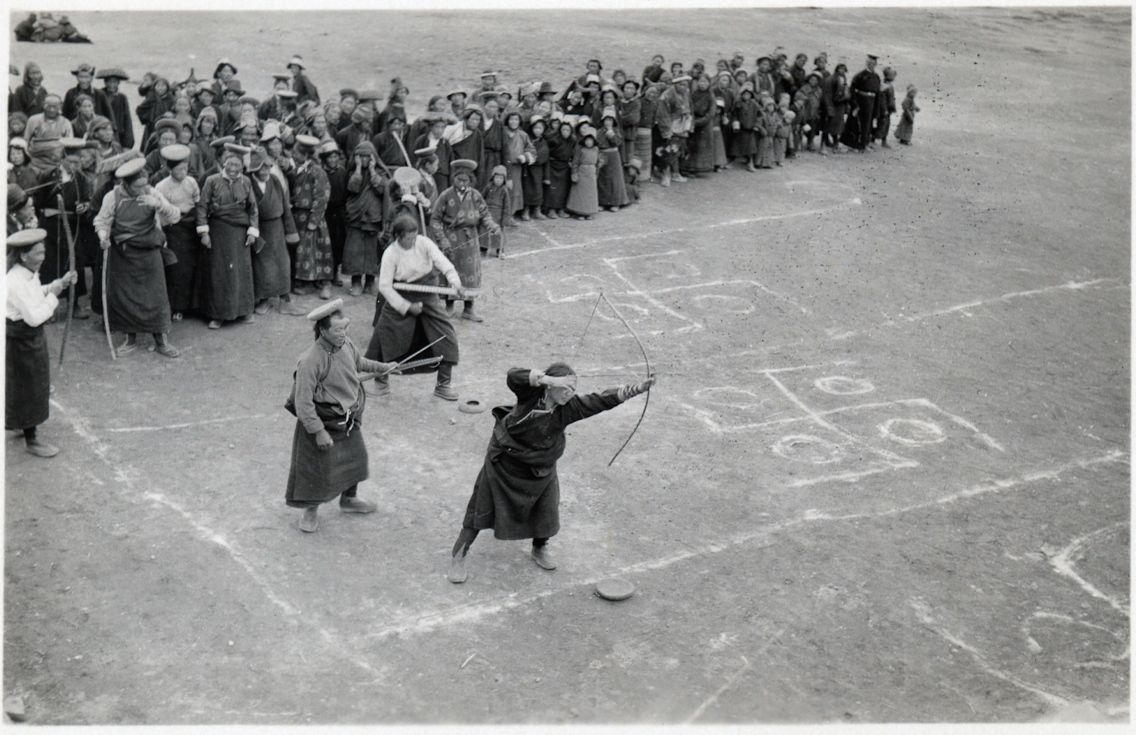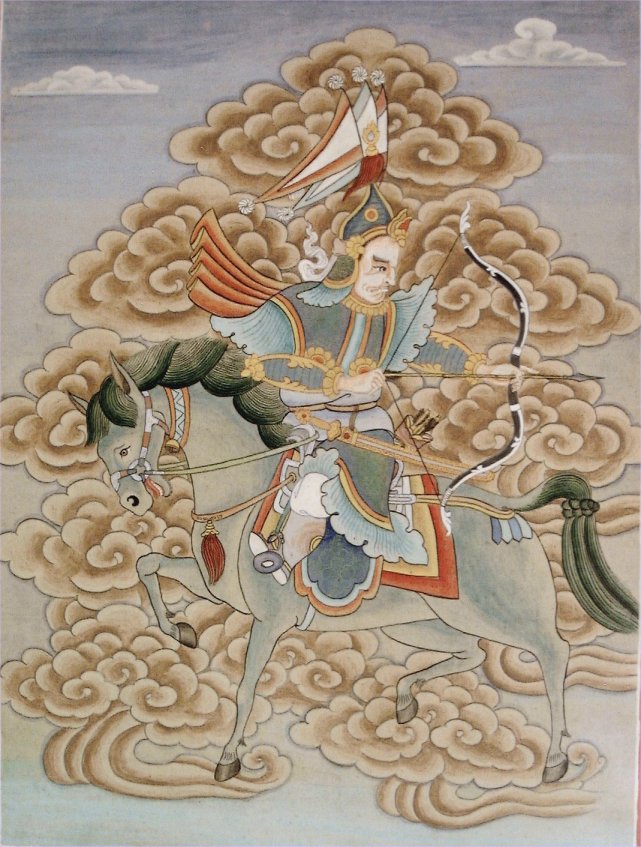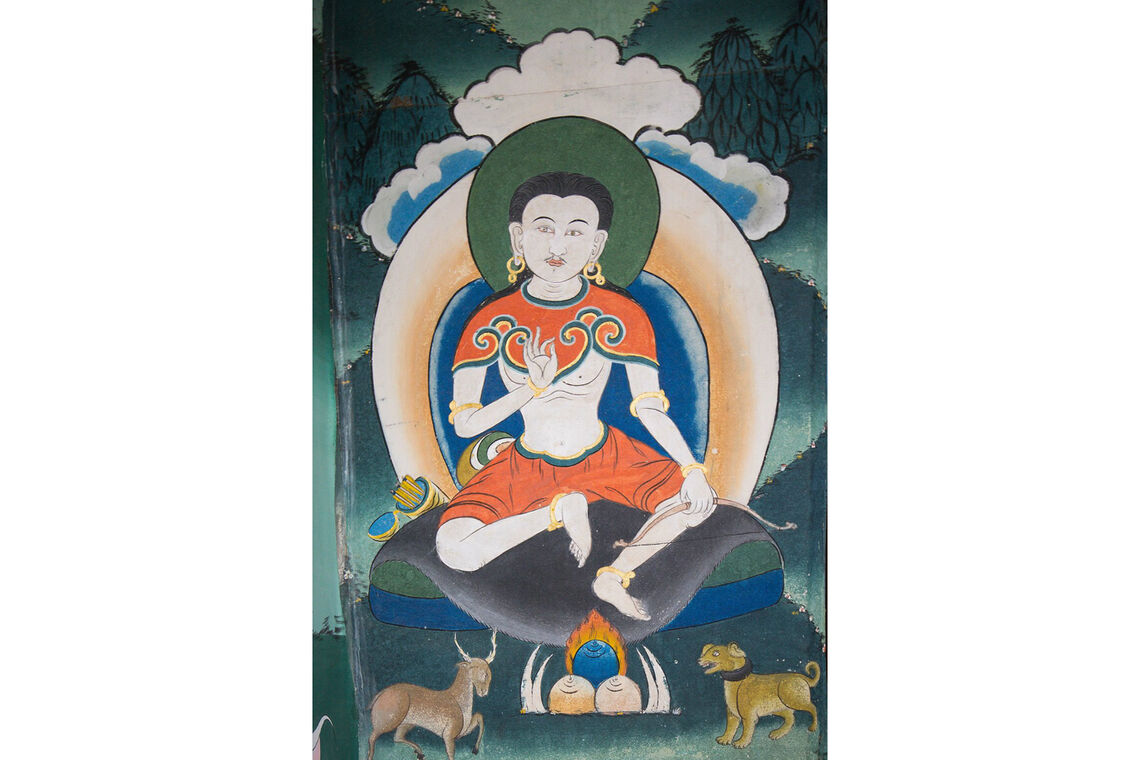Tibetan Archery
Tibetan Archery
Archery has a long and rich history in Tibet, where it has been an important part of the region’s culture and traditions for centuries. Tibetan archery is known for its unique style and techniques, passed down through generations of archers.
Tibetan archery traditionally involved the use of composite bows made of layers of bamboo, wood, and animal horn or sinew. These bows were typically short and had a distinctive recurve shape. Arrows were made from bamboo or reed, with feather fletchings, and were often tipped with metal points or bone tips.
Archery was originally used for hunting and self-defense in Tibet, but over time it became a popular sport and social activity. Archery contests were often held during festivals and special occasions and were an opportunity for people to demonstrate their skills and compete against one another.

One unique aspect of Tibetan archery is using targets made of stone or packed earth, called “doks.” These targets were often placed at a distance of around 100 meters from the archer, and hitting the target required a high degree of accuracy and skill.
Tibetan archery also has a strong spiritual and religious significance. Archery was believed to be a way of connecting with the divine and harnessing spiritual energy. Many archers would recite prayers or mantras before shooting, and there were even specific rituals and ceremonies associated with archery.
Today, Tibetan archery is still practiced in some parts of Tibet and among Tibetan communities in other parts of the world. However, the sport has also faced challenges in recent years due to the political situation in Tibet and the modernization of traditional Tibetan culture. Despite these challenges, Tibetan archery remains an integral part of the region’s cultural heritage and continues to be celebrated and practiced by many.
This article explores Tibetan archery as well as some history of Tibet itself.

Tibet – The Roof of the World
Before we delve into Tibetan archery specifically, let us briefly examine some history of Tibet itself. Tibet is unique geographically as it is the highest place on earth. Located in the Himalayas, the Tibetan Plateau is situated at an elevation of 4,380 m (14,000 ft) above sea level. Tibet also hosts the tallest mountain in the world, Mount Everest, which has an elevation of 8,848.86 m (29,032 ft).
The area of what is modern-day Tibet has been inhabited by humans for quite some time. There has been human occupation of the area since the paleolithic, specifically approximately 21,000 years ago. This early population experienced an influx of immigrants from northern China about 3000 years ago Despite migrations through or into Tibet, recent genetic testing reveals a partial continuity of the genes of modern Tibetans with their paleolithic ancestors.[1]

The Tibetan Empire
Tibet, also known in Tibetan as Bod (བོད་), became an empire with the rule of Songtsen Gampo (604–650 CE). This legendary leader accomplished a great deal during his reign besides just unifying the various former Tibetan kingdoms and founding an empire.
After unifying the various tribes and regions of Tibet and establishing a centralized government, Songtsen Gampo is also credited with building many of Lhasa’s (Tibel’s capital) most important landmarks, such as the Jokhang Temple and the iconic Potala Palace.
Along with his administrative and diplomatic successes for which he is known Songtsen Gampo also established the religion for which Tibet is famously known, namely Buddhism. It is traditionally accepted that Songtsen’s first wife the Princess of Nepal, Bhrikuti, was instrumental in influencing her husband and therefore Tibet in its acceptance of the new religion.
Before Songtsen Gampo’s reign, Tibet had no written language and relied solely on oral traditions for the transmission of information and knowledge. However, Songtsen Gampo recognized the importance of a written language for the advancement of his kingdom and sent scholars to study the writing systems of neighboring regions such as India, China, and Nepal.
Based on what they learned, Songtsen Gampo and his advisers developed a new writing system for Tibet, known as the Tibetan script. The script was based on the Brahmi script used in India but was adapted to the unique phonetics and grammar of the Tibetan language.

The creation of the Tibetan script was a significant development in Tibetan history, as it allowed for the preservation and dissemination of Tibetan literature, history, and religion in written form. It also facilitated communication and exchange with neighboring regions and helped to unify the various tribes and regions of Tibet under a common written language.
In addition to his contributions to the development of the Tibetan script, Songtsen Gampo is also remembered for his role in the spread of Buddhism in Tibet. He is said to have built several important temples and monasteries, including the Jokhang Temple in Lhasa, which is considered one of the holiest sites in Tibetan Buddhism.

Tibetan Warfare
Before we delve into the specifics of Tibetan archery, let us take a broad look at Tibetan warfare in general.
Tibetan warfare has a long and complex history, shaped by geography, culture, and external influences. The Tibetans developed a distinctive approach to warfare, characterized by a combination of guerilla tactics, mounted archery, and defensive fortifications.
One of the key tactics used by Tibetan warriors was guerilla warfare. This involved launching surprise attacks on enemy forces, often at night or in bad weather, and then retreating to the safety of mountain strongholds. Guerilla tactics allowed the Tibetans to overcome their lack of numbers and resources and made it difficult for invading forces to maintain control over the Tibetan plateau.
Another critical tactic was mounted archery. Tibetan warriors were skilled horsemen and archers and could shoot arrows accurately while riding at high speeds. This made them highly mobile on the battlefield and allowed them to harass enemy forces from a distance. Tibetan archers were often equipped with composite bows made from layers of wood, horn, and sinew, which could shoot arrows with great force and accuracy.

In addition to mounted archery, Tibetan warriors also used a variety of weapons and armor. Swords and spears were commonly used in close combat, while bows and arrows were the preferred ranged weapons. Tibetan warriors also wore a variety of armor, including leather and chain mail, and some were known to wear helmets and face masks for added protection.
Defensive Fortifications
Defensive fortifications were another important aspect of Tibetan warfare. Tibetan forts were often built on hilltops or other strategic locations and were designed to withstand enemy assaults. Many forts were constructed using stone and mud brick and featured high walls, towers, and gates. Some forts also had hidden tunnels and escape routes, allowing defenders to escape if the fort was overrun.
Overall, Tibetan warfare was characterized by a combination of guerilla tactics, mounted archery, and defensive fortifications. These strategies allowed the Tibetans to defend their homeland against invading forces for centuries and played a key role in shaping Tibetan history and culture.
A video highlighting some of the major aspects of Tibetan warfare:
The History of Tibetan Archery
The precise time when Archery found its way into Tibet is not known. Yet both the simple self-bow and the composite recurve of the Asiatic style were known and used by the ancient and medieval Tibetans. The composite recurve (wood, horn, sinew) bows appear in the 2nd millennia BCE, yet their precise origin in time and space is uncertain. Being composed of organic matter, few survive for thousands of years in the archeological record.
The Scythians of Central Asia were the first well-documented people to use a composite recurve. They also coupled this superior long-range weapon with the horse. This combination of range and mobility would define warfare on the steppes for thousands of years after the decline of the Scythians.
Being well within the sphere of influence of the steppe nomads, the composite bow (as well as mounted warfare) seems to have made its way into Tibet early in its history. Verification of this comes mostly in the form of rock art which we will discuss in a later section.

Tibetan Archery Sources
Several sources describe Tibetan archery tactics, including historical texts, artwork, and oral traditions. Some of the most important sources include:
- “The Mani Kambum” – This is a Tibetan Buddhist text that contains descriptions of archery techniques and the symbolism of the bow and arrow in Tibetan culture. https://tibetanlaw.org/mani-bka-bum
- Mkhas-pa’i dga’-ston” (The Chronicles of the Kings of Tibet) – This text describes the use of bows and arrows in battle during the reign of the Tibetan king Songtsen Gampo (7th century CE).
- “The Epic of King Gesar” is a long narrative poem that tells the story of a legendary Tibetan warrior-king and contains descriptions of archery tactics and battle scenes.
- Tibetan artwork – Many Tibetan thangkas (scroll paintings) and other forms of art depict archery scenes, providing insight into the tactics and equipment used by Tibetan archers.
- Oral traditions – Tibetan oral traditions have preserved knowledge of archery techniques and tactics, and continue to be passed down through generations of archers and martial artists.
Mentions of Archery in The Mani Kambum
To give the reader an idea of the cultural and spiritual importance placed on archery in Tibet, here are several passages from the text.
- “The bow is the weapon of emptiness, and the arrow is the weapon of compassion. The archer must cultivate both emptiness and compassion to shoot with skill and wisdom.”
- “The bow and arrow are symbols of the wisdom and compassion of the Buddha. Just as the arrow flies straight to its target, so too must the mind of the archer be focused and free from distractions.”
- “The archer must practice diligently and with discipline to master the art of archery. Only then can he or she become a true warrior of the dharma.”
- “In battle, the archer must stay calm and centered, even amid chaos and confusion. The bow and arrow are not just weapons, but also tools for spiritual transformation.”
These passages illustrate the deep spiritual and philosophical significance of archery in Tibetan culture and highlight the importance of mindfulness and discipline in the practice of archery.
Tibetan Archery & The Tibetan Bow
The shape of ancient Tibetan bows may be discerned from various cave drawings. They do differ in shape as depicted by the artist. Also, these drawings may not always be a truly good indicator of bow designs, yet they do give us a glimpse into the remote past. Most of these bows are assumed to be composite recurve bows, as they are shown to have the distinctive curvature (especially the recurved tips) of many Asiatic composite recurves.


As mentioned, both self-bows and composite recurve were known to the Tibetans of bygone ages, and both have been used in more modern times. Many of these self-bows are made from a single cane (sba) [2]. Self-bows made of bamboo are also used for contests. They are known to be fast and efficient bows, as they are used in archery contests where the target is about 145 meters (475 feet) from the archers. Some of these bamboo sports bows are also backed with Yak horn, making them composite bows.
Check out this video of traditional Tibetan bow creation:
Tibetan “Qinghai”
The composite bow used by the Tibetans is known as the Qinghai bow. It is very similar to the mighty Manchu bow used by the Chinese, yet it is notably shorter, with much smaller bow tips or siyahs.
It is also known as the “Koko Nor” bow, named after the lake where it was first made.
The Qinghai bow is a composite bow, meaning it is made up of multiple materials that are combined to create a strong and durable weapon. The bow is made up of a core made of bamboo or wood, which is then covered with layers of animal horn and sinew. These materials are glued together with a special adhesive made from animal bones and tendons.
The Qinghai bow is typically between 140 and 150 centimeters (55 to 59 inches) long and has a draw weight of around 45 to 60 pounds. This makes it a powerful and versatile weapon, suitable for use in hunting, warfare, and traditional archery contests.
In addition to its unique design and materials, the Qinghai bow is also notable for its cultural and historical significance. It has been used by Tibetan archers for centuries and is an important part of Tibetan cultural heritage. Many traditional archery contests in Tibet and China still use the Qinghai bow, and it remains a popular choice among modern archers who appreciate its power, accuracy, and beauty.
Many beautiful examples of still manufactured to this very day by various bowyers. Check out some examples below (CLICK IMAGES FOR PRODUCT LINKS):
The Tibetan Quinhai by Alibow

The Khampa – Tibetan Quinghai by Faribow

Armin from Asiatic Archery did a review on the Khampa for your viewing pleasure:
Tibetan Archery Contests
There is a long tradition of archery contests in Tibet. The tradition goes back millennia and is still enjoyed by Tibetans to this day. The rules of Tibetan archery contests are quite different from those of modern archery contests. In Tibetan archery, the emphasis is on the number of arrows that hit the target, rather than on the accuracy of the shots. It is not uncommon for archers to aim above or to the side of the target to try and hit the other arrows that are already stuck in the target.

Tibetan archery contests are often accompanied by traditional music and dance and are a source of great pride and entertainment for the Tibetan people. The contests are also an opportunity for the archers to display their skills and strength, and for the community to come together and celebrate their culture and traditions.
Today, Tibetan archery contests are still held in Tibet and Tibetan communities around the world. While the contests have become less frequent due to modernization and other factors, they remain an important part of Tibetan culture and heritage.
Check out this video filmed in Tibet during an archery competition. Archived:
https://archive.org/details/TibetanArcheryInterviewContest
In the following section, we will elaborate on some notable Tibetan archery contests.
Tibetan New Year Archery Contest
The Tibetan new year, or Losar, is a significant festival celebrated by Tibetan communities all around the world. One of the most important events during this festival is the traditional archery contest, which has been a part of Tibetan culture for centuries.
The archery contest during the Tibetan new year is called “Dochoong,” which means “the year’s first archery.” It is a highly competitive and festive event that brings together people from different communities and regions to participate in and witness the contest.

The contest usually takes place in a large open field where a wooden target, called “gara,” is set up at a distance of around 100 meters. The gara is usually around three meters high and has a small triangular opening in the center, which is the target area. The archers stand at a distance of around 60 to 70 meters away from the target and shoot arrows toward it.
The archers are divided into two teams, each consisting of around 20 to 30 members. The teams usually represent different regions, villages, or organizations. The contest is divided into three rounds, and each team gets three chances to shoot arrows in each round. The team that hits the target the most times wins the contest.
Apart from the archery contest, the Dochoong festival is also an occasion for cultural performances, feasts, and other festivities. It is a time for the community to come together, celebrate, and renew their spirit for the new year.
Gallop Behind the Fort
The ‘Gallop Behind the Fort’ festival, also known as the “Da Jie” festival, is a traditional Tibetan festival that takes place on the 26th day of the first Tibetan month. It is celebrated in various parts of Tibet and is especially popular in Lhasa, the capital city.
During the festival, participants engage in horse racing, archery, and other games and activities. One of the most popular events is the horse race, where riders compete to be the first to complete a long course that winds through the streets and around the nearby hills. The race is often a test of endurance as well as speed, and riders must navigate tricky obstacles along the way.
In addition to the horse race, there are also archery competitions, where participants shoot at targets placed at various distances. The archery contests are often highly competitive, with participants vying to hit the target with the greatest accuracy and skill.
Other activities during the festival include singing and dancing, as well as the preparation and sharing of traditional foods and drinks. The festival is a time for community members to come together and celebrate the start of the new year, as well as to honor the cultural traditions and heritage of the Tibetan people.
The origins of the ‘Gallop Behind the Fort’ festival are not entirely clear, but it is thought to have been established in the 17th century by the fifth Dalai Lama, Ngawang Lobsang Gyatso. Today, the festival is an important part of Tibetan cultural identity, and it continues to be celebrated with great enthusiasm and fanfare each year.

The Magical Arrow
The Magical Arrow International Ethnic Archery Invitational Tournament, also known as the Magical Arrow Festival, is an annual archery competition held in Tibet since 1998. It is considered the largest archery event in Tibet and attracts participants from various countries, including China, Nepal, Bhutan, Mongolia, and India.
The festival is held in Lhasa and lasts for four days, usually in August. The competition features traditional archery techniques and targets, with both men and women participating in different categories. The tournament is divided into two categories, namely the “open category” and the “ethnic category.”
The open category is open to participants of all ethnicities and nationalities, and the competition involves shooting at targets with modern archery equipment. In contrast, the ethnic category is reserved for participants from ethnic groups in China, including the Tibetans, Mongolians, and Han Chinese, and they must use traditional archery equipment such as the Tibetan bow and arrow.
The festival also features other cultural activities, such as folk dance performances, traditional music performances, and exhibitions of Tibetan handicrafts and food. The event is an opportunity for people to learn more about Tibetan culture and heritage, as well as to promote tourism in the region.
The Magical Arrow Festival is not just a sporting event but also an important cultural celebration in Tibet, bringing together people from various ethnic groups to celebrate their shared heritage and traditions. It has become an integral part of the cultural and sporting calendar in Tibet, and its popularity continues to grow with each passing year.

Tibetan Archery in Tibetan Art
Tibetan art is dramatic, colorful, and vivid, some would even call it psychedelic. This art has a rich tradition of depicting archery and archers in various forms. Here are some examples of Tibetan artworks that prominently feature archery:
- Thangkas: Thangkas are traditional Tibetan paintings on cotton or silk that often depict Buddhist deities or spiritual figures. Many thangkas include depictions of archery, such as the Green Tara thangka which shows her holding a bow and arrow.
- Sculptures: Tibetan sculptures, particularly those from the 14th century onwards, often include depictions of archers. For example, the Guhyasamaja Tantra, a Tibetan Buddhist text, describes a wrathful deity named Hevajra who is often depicted in sculptures holding a bow and arrow.
- Tibetan Carpet designs: Tibetan carpets are also known for featuring designs with archery and archers. These carpets often depict scenes from Tibetan history or mythology and can be found in many Tibetan homes and monasteries.
- Thangka tapestries: Similar to traditional thangkas, thangka tapestries are made using traditional painting techniques but are woven into the fabric rather than painted on silk or cotton. These tapestries often depict archery and archers in various settings and contexts.
- Woodblock prints: Tibetan woodblock prints, which date back to the 9th century, often feature scenes of archery and hunting. These prints were commonly used for religious texts or as illustrations for folktales and legends.
These are just a few examples of Tibetan artworks that feature archery and archers. There are many more examples throughout Tibetan art and culture that highlight the importance of archery in Tibetan history and mythology.

The Cultural Importance of Archery in Bhutan and Other Himalayan Regions
Other nations in the Himalayan regions such as Nepal and Bhutan also have a rich history and relationship with archery which we will cover in future articles. Stay tuned.
[1] Zhao, M; Kong, QP; Wang, HW; Peng, MS; Xie, XD; Wang, WZ; Jiayang, Duan JG; Cai, MC; Zhao, SN; Cidanpingcuo, Tu YQ; Wu, SF; Yao, YG; Bandelt, HJ; Zhang, YP (2009). “Mitochondrial genome evidence reveals successful Late Paleolithic settlement on the Tibetan Plateau”. Proc Natl Acad Sci U S A. 106 (50): 21230–21235. Bibcode:2009PNAS..10621230Z. doi:10.1073/pnas.0907844106. PMC 2795552. PMID 19955425.
[2] https://www.tibetarchaeology.com/march-2013/
https://atarn.org/
https://en.wikipedia.org/wiki/Tibetan_Empire
https://www.metmuseum.org/toah/hd/tbar/hd_tbar.htm
https://www.tibettravel.org/news/201404141469.html
http://www.manchuarchery.org/photographs-tibetan-archers#:~:text=Tibetan%20archery%20goes%20back%20a,a%20long%20eared%20composite%20bow.
Thank You.
